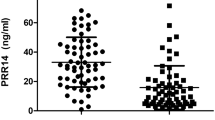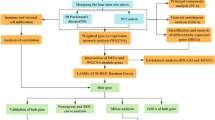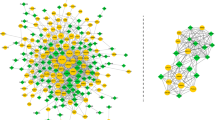Abstract
Parkinson’s disease (PD) is a slowly progressive geriatric disease, which can be one of the leading causes of serious socioeconomic burden in the aging society. Clinical trials suggest that prompt treatment of early-stage Parkinson’s disease (EPD) may slow down the disease progress and have a better response. Therefore, conducting proteomics study to identify biomarkers for the diagnosis and disease-modifying therapies of EPD is vital. We aimed at identifying distinct protein autoantibody biomarkers of EPD by using the database of GSE62283 based on the platform GPL13669 downloaded from Gene Expression Omnibus database. Differentially expressed proteins (DEPs) between the EPD group (n = 103) and the normal control (NC) group (n = 111) were identified by protein-specific t test. Cluster analysis of DEPs was conducted by protein–protein interaction network to detect hub proteins. The hub proteins were then evaluated to determine the distinct biomarkers by principal component analysis, as well as functional and pathway enrichment analysis. Their biological functions were confirmed by gene ontology functional (GO) and Kyoto encyclopedia of genes and genomes pathway enrichment (KEGG). Two biomarkers, mitochondrial ribosome recycling factor (MRRF) and ribosomal protein S18 (RPS18), distinguished the EPD samples from the NC samples, and they were regarded as high-confidence distinct protein autoantibody biomarkers of EPD. The most significant GO function was protein serine/threonine kinase activity (GO: 0004674) and most of DEPs were enriched in ATP binding in molecular function category (GO: 0005524). These results may help in establishing the prompt and accurate diagnosis of EPD and may also contribute to develop mechanism-based treatments.





Similar content being viewed by others
Abbreviations
- PD:
-
Parkinson’s disease
- EPD:
-
Early-stage Parkinson’s disease
- NC:
-
Normal control
- DEPs:
-
Differentially expressed proteins
- KEGG:
-
Kyoto encyclopedia of genes and genomes
- GO:
-
Gene ontology
- PPI:
-
Protein–protein interaction
- α-syn:
-
α-Synuclein
- PCA:
-
Principal component analysis
References
Lin X, Cook TJ, Zabetian CP, Leverenz JB, Peskind ER, Hu SC, Cain KC, Pan C, Edgar JS, Goodlett DR, Racette BA, Checkoway H, Montine TJ, Shi M, Zhang J (2012) DJ-1 isoforms in whole blood as potential biomarkers of Parkinson disease. Sci Rep 2:954. https://doi.org/10.1038/srep00954
Zhao YJ, Wee HL, Chan YH, Seah SH, Au WL, Lau PN, Pica EC, Li SC, Luo N, Tan LC (2010) Progression of Parkinson’s disease as evaluated by Hoehn and Yahr stage transition times. Mov Disord 25(6):710–716. https://doi.org/10.1002/mds.22875
Ma CL, Su L, Xie JJ, Long J-x, Wu P, Gu L (2014) The prevalence and incidence of Parkinson’s disease in China systematic review and meta-analysis. J Neural Transm 121:123–134. https://doi.org/10.1007/s00702-013-1092-z)
Dorsey ER, Constantinescu R, Thompson JP, Biglan KM, Holloway RG, Kieburtz K, Marshall FJ, Ravina BM, Schifitto G, Siderowf A, Tanner CM (2007) Projected number of people with Parkinson disease in the most populous nations, 2005 through 2030. Neurology 68(5):384–386. https://doi.org/10.1212/01.wnl.0000247740.47667.03
Rodriguez-Blazquez C, Forjaz MJ, Lizan L, Paz S, Martinez-Martin P (2015) Estimating the direct and indirect costs associated with Parkinson’s disease. Expert Rev Pharmacoecon Outcomes Res 15(6):889–911. https://doi.org/10.1586/14737167.2015.1103184
Zhao YJ, Wee HL, Au WL, Seah SH, Luo N, Li SC, Tan LC (2011) Selegiline use is associated with a slower progression in early Parkinson’s disease as evaluated by Hoehn and Yahr stage transition times. Parkinsonism Relat Disord 17(3):194–197. https://doi.org/10.1016/j.parkreldis.2010.11.010
Schrag A, Spottke A, Quinn NP, Dodel R (2009) Comparative responsiveness of Parkinson’s disease scales to change over time. Mov Disord 24(6):813–818. https://doi.org/10.1002/mds.22438
Scanlon BK, Katzen HL, Levin BE, Singer C, Papapetropoulos S (2008) A formula for the conversion of UPDRS-III scores to Hoehn and Yahr stage. Parkinsonism Relat Disord 14(4):379–380. https://doi.org/10.1016/j.parkreldis.2007.09.010
Hoehn M, Yahr M (2011) Parkinsonism: Onset, progression, and mortality. Neurology 77(9):874–874. https://doi.org/10.1212/01.wnl.0000405146.06300.91
Tsanas A, Little MA, McSharry PE, Scanlon BK, Papapetropoulos S (2012) Statistical analysis and mapping of the unified Parkinson’s disease rating scale to Hoehn and Yahr staging. Parkinsonism Relat Disord 18(5):697–699. https://doi.org/10.1016/j.parkreldis.2012.01.011
Reichmann H (2010) Clinical criteria for the diagnosis of Parkinson’s disease. Neurodegener Dis 7(5):284–290. https://doi.org/10.1159/000314478
Kalia LV, Lang AE (2015) Parkinson’s disease. Lancet 386(9996):896–912. https://doi.org/10.1016/s0140-6736(14)61393-3
Marconi S, Zwingers T (2014) Comparative efficacy of selegiline versus rasagiline in the treatment of early Parkinson’s disease. Eur Rev Med Pharmacol Sci 18(13):1879–1882
Fahn S (2008) The history of dopamine and levodopa in the treatment of Parkinson’s disease. Mov Disord 23(Suppl 3):S497–S508. https://doi.org/10.1002/mds.22028
Group PsS (1996) Impact of deprenyl and tocopherol treatment on Parkinson’s disease in DATATOP patients requiring levodopa. Ann Neurol 39(1):37–45
Adler CH, Beach TG, Hentz JG, Shill HA, Caviness JN, Driver-Dunckley E, Sabbagh MN, Sue LI, Jacobson SA, Belden CM, Dugger BN (2014) Low clinical diagnostic accuracy of early vs advanced Parkinson disease: clinicopathologic study. Neurology 83(5):406–412. https://doi.org/10.1212/WNL.0000000000000641
Miller DB, O’Callaghan JP (2015) Biomarkers of Parkinson’s disease: present and future. Metabolism 64(3 Suppl 1):S40–S46. https://doi.org/10.1016/j.metabol.2014.10.030
Sulzer D, Cassidy C, Horga G, Kang UJ, Fahn S, Casella L, Pezzoli G, Langley J, Hu XP, Zucca FA, Isaias IU, Zecca L (2018) Neuromelanin detection by magnetic resonance imaging (MRI) and its promise as a biomarker for Parkinson’s disease. NPJ Parkinson's disease 4:11. https://doi.org/10.1038/s41531-018-0047-3
George S, Brundin P (2015) Immunotherapy in Parkinson’s disease: micromanaging alpha-synuclein aggregation. J Parkinsons Dis 5(3):413–424. https://doi.org/10.3233/JPD-150630
DeMarshall CA, Han M, Nagele EP, Sarkar A, Acharya NK, Godsey G, Goldwaser EL, Kosciuk M, Thayasivam U, Belinka B, Nagele RG, Parkinson’s Study Group I (2015) Potential utility of autoantibodies as blood-based biomarkers for early detection and diagnosis of Parkinson’s disease. Immunol Lett 168(1):80–88. https://doi.org/10.1016/j.imlet.2015.09.010
Bougea A, Stefanis L, Paraskevas GP, Emmanouilidou E, Vekrelis K, Kapaki E (2019) Plasma alpha-synuclein levels in patients with Parkinson’s disease: a systematic review and meta-analysis. Neurological Sciences 40(5):929–938. https://doi.org/10.1007/s10072-019-03738-1
Alegre-Abarrategui J, Ansorge O, Esiri M, Wade-Martins R (2008) LRRK2 is a component of granular alpha-synuclein pathology in the brainstem of Parkinson’s disease. Neuropathol Appl Neurobiol 34(3):272–283. https://doi.org/10.1111/j.1365-2990.2007.00888.x
Mills RD, Sim CH, Mok SS, Mulhern TD, Culvenor JG, Cheng HC (2008) Biochemical aspects of the neuroprotective mechanism of PTEN-induced kinase-1 (PINK1). J Neurochem 105(1):18–33. https://doi.org/10.1111/j.1471-4159.2008.05249.x
Reetz K, Lencer R, Steinlechner S, Gaser C, Hagenah J, Buchel C, Petersen D, Kock N, Djarmati A, Siebner HR, Klein C, Binkofski F (2008) Limbic and frontal cortical degeneration is associated with psychiatric symptoms in PINK1 mutation carriers. Biol Psychiatry 64(3):241–247. https://doi.org/10.1016/j.biopsych.2007.12.010
van Duijn CM, Dekker MC, Bonifati V, Galjaard RJ, Houwing-Duistermaat JJ, Snijders PJ, Testers L, Breedveld GJ, Horstink M, Sandkuijl LA, van Swieten JC, Oostra BA, Heutink P (2001) Park7, a novel locus for autosomal recessive early-onset parkinsonism, on chromosome 1p36. Am J Human Genet 69(3):629–634. https://doi.org/10.1086/322996
Huang DW, Sherman BT, Tan Q, Collins JR, Alvord WG, Roayaei J, Stephens R, Baseler MW, Lane HC, Lempicki RA (2007) The DAVID gene functional classification tool: a novel biological module-centric algorithm to functionally analyze large gene lists. Genome Biol 8(9):R183. https://doi.org/10.1186/gb-2007-8-9-r183
Consortium GO (2015) Gene ontology consortium: going forward. Nucleic Acids Res 43:1049–1056
Kanehisa M, Goto S, Furumichi M, Tanabe M, Hirakawa M (2010) KEGG for representation and analysis of molecular networks involving diseases and drugs. Nucleic Acids Res 38(Database issue):D355–D360. https://doi.org/10.1093/nar/gkp896
Von Mering CHM, Jaeggi D, Schmidt S, Bork P, Snel B (2003) STRING: a database of predicted functional associations between proteins. Nucleic Acids Res 31:258–261
Kohl M, Wiese S, Warscheid B (2011) Cytoscape: software for visualization and analysis of biological networks. Methods Mol Biol 696(696):291–303. https://doi.org/10.1007/978-1-60761-987-1_18
Soreq L, Bergman H, Israel Z, Soreq H (2013) Deep brain stimulation modulates nonsense-mediated RNA decay in Parkinson’s patients leukocytes. BMC Genomics 14:478. https://doi.org/10.1186/1471-2164-14-478
Perier C, Bove J, Vila M (2012) Mitochondria and programmed cell death in Parkinson’s disease: apoptosis and beyond. Antioxid Redox Signal 16(9):883–895. https://doi.org/10.1089/ars.2011.4074
Niranjan R (2014) The role of inflammatory and oxidative stress mechanisms in the pathogenesis of Parkinson’s disease: focus on astrocytes. Mol Neurobiol 49(1):28–38. https://doi.org/10.1007/s12035-013-8483-x
Sim CH, Lio DS, Mok SS, Masters CL, Hill AF, Culvenor JG, Cheng HC (2006) C-terminal truncation and Parkinson’s disease-associated mutations down-regulate the protein serine/threonine kinase activity of PTEN-induced kinase-1. Human Mol Genet 15(21):3251–3262. https://doi.org/10.1093/hmg/ddl398
Inamdar AA, Masurekar P, Hossain M, Richardson JR, Bennett JW (2014) Signaling pathways involved in 1-octen-3-ol-mediated neurotoxicity in Drosophila melanogaster: implication in Parkinson’s disease. Neurotox Res 25(2):183–191. https://doi.org/10.1007/s12640-013-9418-z
Jha SK, Jha NK, Kar R, Ambasta RK, Kumar P (2015) p38 MAPK and PI3K/AKT signalling cascades in Parkinson’s disease. Int J Mol Cell Med 4(2):67–86
EMBL-EBI Quick GO (2009) https://wwwe.biacuk/QuickGO/. Accessed 3 Apr 2018
ElAli A, Hermann DM (2011) ATP-binding cassette transporters and their roles in protecting the brain. Neuroscientist 17(4):423–436. https://doi.org/10.1177/1073858410391270
Taymans JM, Nkiliza A, Chartier-Harlin MC (2015) Deregulation of protein translation control, a potential game-changing hypothesis for Parkinson’s disease pathogenesis. Trends Mol Med 21(8):466–472. https://doi.org/10.1016/j.molmed.2015.05.004
Olanow CW, Schapira AH (2013) Therapeutic prospects for Parkinson disease. Ann Neurol 74(3):337–347. https://doi.org/10.1002/ana.24011
AlDakheel A, Kalia LV, Lang AE (2014) Pathogenesis-targeted, disease-modifying therapies in Parkinson disease. Neurotherapeutics 11(1):6–23. https://doi.org/10.1007/s13311-013-0218-1
Lin MT, Beal MF (2006) Mitochondrial dysfunction and oxidative stress in neurodegenerative diseases. Nature 443(7113):787–795. https://doi.org/10.1038/nature05292
Voshavar C, Shah M, Xu L, Dutta AK (2015) Assessment of protective role of multifunctional dopamine agonist D-512 against oxidative stress produced by depletion of glutathione in PC12 cells: implication in neuroprotective therapy for Parkinson’s disease. Neurotox Res 28(4):302–318. https://doi.org/10.1007/s12640-015-9548-6
Bhat AH, Dar KB, Anees S, Zargar MA, Masood A, Sofi MA, Ganie SA (2015) Oxidative stress, mitochondrial dysfunction and neurodegenerative diseases; a mechanistic insight. Biomed Pharmacother 74:101–110. https://doi.org/10.1016/j.biopha.2015.07.025
Muftuoglu M, Elibol B, Dalmizrak O, Ercan A, Kulaksiz G, Ogus H, Dalkara T, Ozer N (2004) Mitochondrial complex I and IV activities in leukocytes from patients with parkin mutations. Mov Disord 19(5):544–548. https://doi.org/10.1002/mds.10695
Ryan BJ, Hoek S, Fon EA, Wade-Martins R (2015) Mitochondrial dysfunction and mitophagy in Parkinson’s: from familial to sporadic disease. Trends Biochem Sci 40(4):200–210. https://doi.org/10.1016/j.tibs.2015.02.003
Gotz ME, Double K, Gerlach M, Youdim MB, Riederer P (2004) The relevance of iron in the pathogenesis of Parkinson’s disease. Ann N Y Acad Sci 1012:193–208
Jiang D, Shi S, Zhang L, Liu L, Ding B, Zhao B, Yagnik G, Zhou F (2013) Inhibition of the Fe(III)-catalyzed dopamine oxidation by ATP and its relevance to oxidative stress in Parkinson’s disease. ACS Chem Neurosci 4(9):1305–1313. https://doi.org/10.1021/cn400105d
Santiago JA, Potashkin JA (2015) Blood biomarkers associated with cognitive decline in early stage and drug-naive Parkinson’s disease patients. PLoS One 10(11):e0142582. https://doi.org/10.1371/journal.pone.0142582
Sveinbjornsdottir S (2016) The clinical symptoms of Parkinson’s disease. J Neurochem 139(Suppl 1):318–324. https://doi.org/10.1111/jnc.13691
Bonifati V, Rizzu P, van Baren MJ, Schaap O, Breedveld GJ, Krieger E, Dekker MC, Squitieri F, Ibanez P, Joosse M, van Dongen JW, Vanacore N, van Swieten JC, Brice A, Meco G, van Duijn CM, Oostra BA, Heutink P (2003) Mutations in the DJ-1 gene associated with autosomal recessive early-onset parkinsonism. Science (New York, NY) 299(5604):256–259. https://doi.org/10.1126/science.1077209
Funding
This work was supported by the National Key R&D Program of China (grant number 2016YFC1306000).
Author information
Authors and Affiliations
Corresponding author
Ethics declarations
The original study [20] is approved by Rowan-Stratford Institutional Review Board.
Conflict of interest
The authors declare that they have no conflict of interest.
Additional information
Publisher’s note
Springer Nature remains neutral with regard to jurisdictional claims in published maps and institutional affiliations.
Rights and permissions
About this article
Cite this article
Wu, Y., Yao, Q., Jiang, GX. et al. Identification of distinct blood-based biomarkers in early stage of Parkinson’s disease. Neurol Sci 41, 893–901 (2020). https://doi.org/10.1007/s10072-019-04165-y
Received:
Accepted:
Published:
Issue Date:
DOI: https://doi.org/10.1007/s10072-019-04165-y




